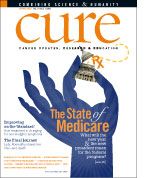Choosing the Right Plan
How to navigate Medicare Part D to get the coverage you need.
I recently helped my mother, a two-time breast cancer survivor of 39 years, choose a Medicare Part D plan for the year. As a 10-year ovarian cancer survivor and a senior policy director for the American Cancer Society Cancer Action Network (ACS CAN), I know that being a survivor makes you look at your choices differently.
That said, it’s important to keep several things in mind when choosing a plan. While cancer patients can benefit from enrolling in a Part D oral drug plan, it is crucial that you evaluate the choices available so you choose the plan that best suits your individual needs. Part D comes with gaps in coverage that require out-of-pocket spending, and not every drug on the market is covered by every Part D plan.
While many of the newer oral cancer drugs are covered under Part D, they are quite expensive. A drug such as Tarceva (erlotinib), which is used to treat lung cancer, can cost up to $36,000 a year. Medicare beneficiaries enrolled in Part D typically pay a quarter of their prescription drug costs after they meet their deductible. In 2009, once you and your plan have paid $2,700 in total drug costs, you hit the “doughnut hole” and are responsible for 100 percent of the cost of your prescription drugs until you have personally paid a total of $4,350 out of your own pocket.
It’s critical to look carefully at Part D plans to determine how much of the total cost you are required to pay for the drugs you need. Many plans have specialty tiers for more expensive drugs, which include most of the newer oral cancer drugs. Instead of a typical co-payment of $20 to $70 for a drug, specialty tiers can charge coinsurance—a set percentage of the cost of the drug.
A recent ACS CAN and Avalere Health study showed that the majority of national Part D plans sampled placed brand-name oral anti-cancer drugs on specialty tiers with an average coinsurance of 26 percent to 35 percent. For a drug like Gleevec (imatinib), coinsurance alone can cost about $1,000 a month. The study also showed a clear trend to move oral anti-cancer drugs to higher cost-sharing tiers, which places a much larger financial burden on some cancer patients.
Here’s a checklist I used to help find a plan for my mom:
>
Find out which plan formularies cover most or all of your cancer drugs (as well as drugs you take for other health conditions)
>
Check how formulary tiers affect what you have to pay
>
Compare plan premiums and cost-sharing requirements, such as deductibles, coinsurance, and co-pays
>
Check for drug conditions or restrictions, such as limits, prior authorizations, and step therapy requirements
>
Determine whether you qualify for the Medicare low-income subsidy
>
Find out which of your cancer drugs are still covered under Part B (intravenous treatments)
>
Determine which off-label drug uses are covered under Part D
>
Understand your appeal rights
>
Check to see if any of the plans offer drug coverage in the doughnut hole
For those who have no other prescription drug coverage, Part D can help cover some of the drug costs. However, cancer patients, survivors, and their families need to be aware of the benefits and challenges related to this plan.
—Christy Schmidt is senior director of policy for the American Cancer Society Cancer Action Network, the advocacy affiliate of the American Cancer Society. For more information, visit www.cancer.org/medicare or www.acscan.org.
